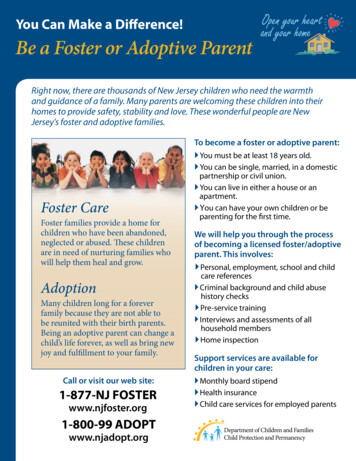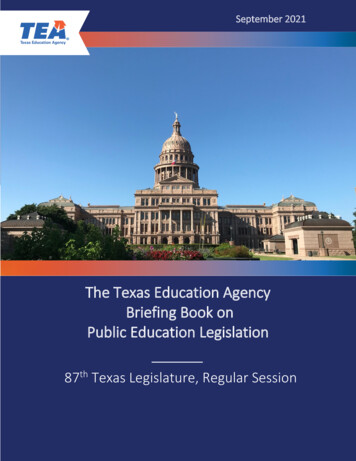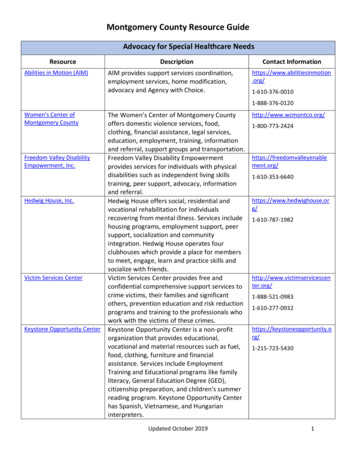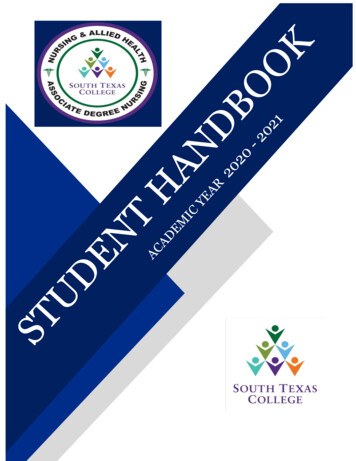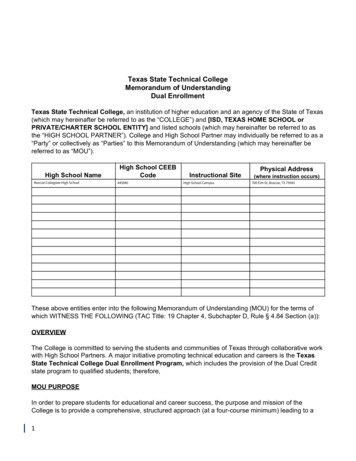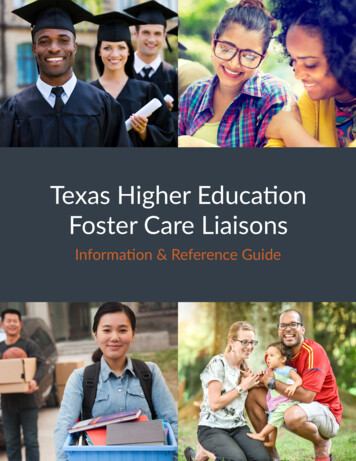
Transcription
A Guide for Foster Care LiaisonsTexas Higher EducationFoster Care LiaisonsInformation & Reference Guide
2
TEXAS HIGHER EDUCATIONCOORDINATING BOARDP.O. Box 12788 Austin, Texas 78711Robert W. JenkinsCHAIRApril 1, 2017Stuart W. StedmanVICE CHAIRDavid D. Teuscher, M.D.SECRETARY OF THE BOARDDear Colleagues:Haley DeLaGarzaSTUDENT REPRESENTATIVEResearch shows that although over 80% of youth in foster care reportwanting to go to college, only 2-9% who attend college receive a bachelor’sdegree. In 2015, the Texas Education Code was amended to require liaisons atall public institutions of higher education in Texas. The higher education fostercare liaison serves a critical role in bridging the gap between the students whowant to pursue higher education and those who have the support needed tocomplete their degree.Arcilia C. AcostaS. Javaid AnwarFred Farias III, O.D.Ricky A. RavenJanelle ShepardJohn T. Steen, Jr.Raymund A. ParedesCOMMISSIONEROF HIGHER EDUCATION512/ 427-6101Fax 512/ 427-6127Web site:http://www.thecb.state.tx.usThis guide was developed to assist foster care liaisons in performing this newrole. The guide includes in-depth information for liaisons who have advocatedfor and with foster care alumni for many years. The guide also providesguidance for new liaisons who are interested in developing a stronger supportnetwork at their institution.With additional information, guidance, and support, liaisons can make atremendous difference in a student’s ability to succeed in higher education.Thank you for your dedication to improving outcomes for all students in Texas,including foster care alumni.Sincerely,AN EQUAL OPPORTUNITY EMPLOYERRaymund A. Paredes3
AcknowledgmentsJessica ArguijoCommunications ManagerChildren’s CommissionKrystal GreenwoodCASA SupervisorDallas CASATraci BakerPreparation for Adult Living CoordinatorTexas Dept. of Family and Protective ServicesJenny HinsonDirector of PlacementTexas Dept. of Family and Protective ServicesJamie BernsteinStaff AttorneyChildren’s CommissionMelody HuslageTexas Dept. of Family and Protective ServicesSheila BustillosPresidentEducation Reach For TexansEdna Ramon ButtsDirector Intergov. Relations & Policy OversightAustin Independent School DistrictKristine MohajerState Education Program SpecialistTexas Dept. of Family and Protective ServicesJane CaldwellHigher Education ProfessionalShannon RamseyTeam Lead, Transitional Living ServicesTexas Dept. of Family and Protective ServicesNatalie CoffeyDirector of Recruitment and RetentionTexas Higher Education Coordinating BoardMary Christine ReedDirector, Texas Foster Youth Justice ProjectTexas Rio Grande Legal Aid, Inc.Jackie DavisCASA SupervisorDallas CASADr. Keri RogersHigher Education ConsultantBriana DoviIntake Social WorkerCarol SelfDivision Administrator for PermanencyTexas Dept. of Family and Protective ServicesLori DukeClinical Professor, Children’s Rights ClinicThe University of Texas School of LawEmily SharpGraphic DesignBrightLeaf GroupLoretta EdelenHigher Education ProfessionalNaomi ValdezThe University of Texas at AustinDr. Monica FaulknerDirectorTexas Institute for Child & Family WellbeingAndrea VicencioAdministrative AssistantChildren’s CommissionLeslie GainesSocial and Community ServicesDr. Toni WattProfessor, Department of SociologyTexas State UniversityAdrian GasparMPAff Candidate, LBJ School of Public AffairsUniversity of Texas at Austin4Kelly KravitzDirector of Highly Mobile and At-Risk TeamTexas Education Agency
Table of ContentsPart IGetting StartedBackground 08Maintaining privacy 15Identifying foster care alumni 16Asking what the student needs 21Benefits overview 22Liaisons and campus support programs 24Helping students find a support system 27Encouraging self-advocacy 30Securing housing, food, and healthcare 32Part II In-depthBenefits, services, and resources for alumni 36Trauma informed practice 50Glossary of helpful terms 54Additional resources 58Endnotes 615
6
Part IGetting StartedBackground 08Maintaining privacy 15Identifying foster care alumni 16Asking what the student needs 21Benefits overview 22Liaisons and campus support programs 24Helping students find a support system 27Encouraging self-advocacy 30Securing housing, food, and healthcare 327
BackgroundUnder Texas Education Code (TEC) Section 51.9356, each institution of higher education must appointat least one employee to serve as a liaison for students formerly in the conservatorship of the TexasDepartment of Family and Protective Services (DFPS).1 Institutions of higher education include any publictechnical institute, public junior college, public senior college or university, medical or dental unit, publicstate college, or other agency of higher education as defined in the law.2The law outlines the following duties for the higher education foster care liaison: Provide information to foster care alumni regarding support services; Inform these students about other resources available at the institution; and Provide any other relevant information to assist the students.3To help liaisons fulfill these duties, this guide will provide information on the following topics: What challenges do foster care alumni face before, during, and after entering thepostsecondary education environment? What is the role of the higher education foster care liaison? What network and supports are available to assist the liaison in this role? What benefits and resources are available to support the student? What is the impact of trauma on the student’s ability to attain educational success? What is the difference between a liaison and a program and how to build capacity?As the liaison, you play a critical part in facilitating educational success for a student population that hasovercome many challenges to complete high school and seek higher education. The presence of a caringadult and consistent point of contact can have a tremendous impact on the lives of foster care alumni.Being a foster care liaison on your campus is an important job requiring a specific knowledge base.This guide was created to: Offer you the tools needed to be successful in your position as foster care liaison atyour campus; Identify key local, state, and national stakeholders and resources; and Highlight effective recruitment and retention strategies for working with foster care alumni.Thank you for your dedication to supporting foster care alumni!8
Key TermsHigher education foster care liaisons serve as a point of contact both on and outside the college oruniversity campus.On campus, liaisons coordinate interactions between: Foster care alumni; and College and University professionals who serve the specific needs of foster care alumni(ex: financial aid, housing).Outside campus, liaisons collaborate with: Higher education professionals interested in networking with foster care alumniacross campuses; and Foster care liaisons at local independent school districts or charter schools, the Texas HigherEducation Coordinating Board (THECB), and/or the Texas Education Agency (TEA); and Child welfare stakeholders, including DFPS.Note, many colleges and universities refer to the liaison with different titles such as “foster carechampion” or “transition coaches”. For the purposes of this guide, the higher education foster care liaisonwill be referred to as the “liaison” or “higher ed liaison”.K-12 district liaison is an individual appointed by a school district or open-enrollment charter school tofacilitate the enrollment, records transfer, or withdrawal of students served in that district or school.Tuition and fee waiver is an exemption, under state law, from tuition and fees charged by Texas publicinstitutions of higher education. Many students formerly in foster care, including those whose custody wasawarded to a non-parent and certain students who return to the legal responsibility of their parents, canqualify to have tuition and fees waived at state supported colleges or universities. There are a variety ofother tuition exemptions and waivers for other student populations. This guide addresses the tuition andfee waivers under TEC Sections 54.366 and 54.367. Waivers cover tuition and fees but not living expenses,books, or supplies. You can find more details about the tuition and fee waiver on page 39.Foster care alumni/students formerly in care are youth and young adults who experienced foster careor were a “dependent or ward of the state,” including those who exited foster care at age 18, referred toas “aging out.” This term also applies to the young adults who voluntarily remain in extended foster carebetween the ages of 18 and 21. Extended foster care is explained in greater detail later in the guide. Theterm “students formerly in care” is used interchangeably with “foster care alumni” throughout this guide.In this guide, these terms apply to students who are eligible for the tuition and fee waiver.9
Background? ? Foster Care 101What is foster care?When children can’t live safely at home and an appropriate non-custodial parent, relative, or close familyfriend is currently unable or unwilling to care for them, the court can give temporary legal possessionto DFPS. Child Protective Services (CPS) is a division of DFPS and assumes planning responsibility forchildren and youth who are removed from their parents. Courts place children in foster care by issuing acourt order giving DFPS conservatorship of the child.Foster care is meant to be temporary - to last only until a permanent living arrangement is found andCPS no longer has legal custody of the child. However, for some children, it can become permanent. CPSstrives to obtain stability and positive permanency for every child who enters foster care, including placingchildren with their siblings. Despite these efforts, children in foster care may have to change placementsseveral times while in foster care due to a variety of factors, such as changes in the foster home or facility,licensing standards violations, or court rulings. It is important to remember that foster care alumni mayhave encountered multiple challenges during childhood and this may affect their responses to both thepostsecondary environment and outreach efforts.Commonly used terms: Conservatorship is another term used to describe the status of a child or youth who is placed inDFPS legal care, custody, and control by a court order. Temporary Managing Conservatorship (TMC) is the awarding of conservatorship of a child or Permanent Managing Conservatorship (PMC) is the placement of a child or youth in theyouth to DFPS. This may include a child remaining in their home with orders from the court forparticular requirements to ensure the safety of the child or the removal of a child from the familyfor safety and well-being purposes.permanent conservatorship of an entity or person, by court order, (e.g. DFPS, relative) with nointention of returning the child to the parent’s custody.Although not as commonly referenced, “substitute care” is interchangeable with the terms “foster care” or“conservatorship.” The Free Application for Federal Student Aid (FAFSA) uses the term a “dependent” or “wardof the court” which are other terms to describe “foster care.” The term “foster care” is being used throughoutthis guide to refer to all children and youth who have been in DFPS conservatorship/substitute care.How does a child or youth enter the foster care system?A child or youth enters the foster care system when there is a “reason to believe” allegation of abuse and/or neglect. CPS must petition the court for approval to remove a child from his or her home because ofsafety concerns. Before a decision is made to remove a child, CPS must make reasonable efforts to safelymaintain children with their families, including sometimes providing necessary supports and services. Toensure that reasonable efforts are made to keep children in their homes, courts must approve all decisionsto remove a child from their home.10
What types of abuse/neglect does Child Protective Services investigate?Child Protective ServicesEmotional AbuseLabor and Sex TraffickingPhysical AbusePhysical NeglectSexual AbuseMedical NeglectAbandonmentNeglectful SupervisionRefusal to Assume Parental ResponsibilityDefinitions of abuse and neglect which may result in an investigation and placement in foster care are laidout in the Texas Family Code.4Where does a child or youth live when placed in foster care?There are a variety of different placement types for children, youth, and young adults in foster care.Each placement is selected based on the child’s needs and the ability of the caregiver to best meet thechild’s needs. The goal of each placement is to provide a child or youth with a safe, stable, and nurturingenvironment. Below is a list of placement types in which a child, youth, or young adult in foster care may live: Kinship Caregiver: A relative or fictive kin who provides care for a child. A relative is a memberof the child’s biological family. A fictive kin is a person who has a longstanding and significantrelationship with the child or with the child’s family. Foster Home: A state-licensed home (usually temporary) for children in foster care. Caregivers Emergency Shelter: A shelter facility that houses youth for up to 90 days while awaiting a longer Group Home: A licensed facility where multiple youth live. Staff oversee the facility and students Residential Treatment Centers (RTC): Residential Treatment Centers are regulated by DFPS to Extended Foster Care: is a voluntary program that offers young adults (ages 18 up to 22)known as “foster parents” receive a reimbursement for providing room, board, and transportationfor children living in their home.term foster placement.live there 24/7.provide placements and services to youth who require specialized services.opportunities to continue their foster care placement and facilitate the transition to independencewith DFPS supervision, if there is an available placement. To qualify, a young adult must have beenin DFPS conservatorship the day before his or her 18th birthday.11
Background Supervised Independent Living (SIL) program: An option for young adults in extended fostercare to live in a variety of settings including apartments, dorms, and shared housing. SIL allowsyoung adults to live independently with increased responsibility and without 24-hour supervision.Young adults placed in SIL settings receive minimum case management services. This arrangementallows young adults to practice necessary independent living skills and achieve self-sufficiency in asupportive environment before leaving the placement.5With the exception of the Extended Foster Care and SIL programs, many children and youth in fostercare experience one or more of these types of living arrangements during their time in foster care. Theseexperiences will undoubtedly influence the student’s experiences in the postsecondary environment.For instance, some students may be used to strict rules and supervision and the unstructured dormenvironment could be a challenge. The liaison should check in with these students to ensure their livingarrangements are stable, safe, and appropriate to meet their needs.How does a child or youth exit the foster care system?DFPS strives to keep every child and youth’s stay in DFPS conservatorship as brief as possible and seeks tofind a permanent setting which includes a legal relationship to a family. Every child or youth in foster carehas a permanency goal which is reviewed and approved by the court. This is a long term plan for the childthat includes the following options:Family ReunificationAdoption by arelative, kin, orunrelated personPermanentmanagingconservatorship toa relative or suitableindividualAnother PlannedPermanent livingArrangement(APPLA) (e.g.independent living,community care)If DFPS is unable to achieve positive permanency for a child or youth, then it is incumbent upon the agencyto identify, develop, and support connections to caring adults who agree to provide support to the youthonce the youth ages out of the foster care system. The APPLA goal is to be used as a last resort when otherplans are inappropriate or have failed. The timing and exit to permanency may affect eligibility for keybenefits so it is important for students to be aware of these details.12
Impact of Foster Care on EducationAccording to the National Working Group on Foster Care and Education, 50% of youth in foster carecomplete high school by age 18.6 Although 84% of 17-18 year old youth in foster care report wanting to goto college, 20% of youth in foster care who graduate from high school attend college, and only 2-9% go onto attain a bachelor’s degree.7 In the long term, research shows that young adults formerly in care are alsomore likely to be unemployed, earn significantly less income, and experience economic hardship8 than areyoung adults who have not been in foster care. To understand these outcomes, it is important to lay somecontext about the challenges facing students formerly in care.First and foremost is a lack of stability in foster care. Although every situation is unique, when a child oryouth enters foster care, their life is inevitably turned upside down. Many children and youth experiencemultiple living situations, referred to as placements, during their time in foster care. Some placementsmay be more of the nature of a shelter or a facility than a home. In 2015, 83.5% of children in substitutecare 12 months or less had 2 or fewer placements but youth who aged out of foster care averaged 6.5placements.9Lack of school stability also impacts educational success. Of 17-18 year olds in foster care, 34%experience 5 or more school changes during their time in care.10 In Texas, the percentage of studentsin foster care who attended two or more schools in one school year is 6.5 times that of other studentsstatewide.11 Ultimately, this instability in the school setting often leads to a devastating loss of academicprogress, credits, connections to peers and supportive adults, and opportunities to develop study and lifeskills. The gaps in learning and social development may create unique challenges for the foster care alumnion your campus such as feeling isolated, unprepared, or out of place.Another difficult challenge for foster care alumni is addressing the history of trauma, grief, and lossassociated with being removed from biological family including parents, siblings, or other relatives, as wellas experiences with the foster care system itself. More information on serving foster care alumni throughtrauma informed practices is available later in this guide.Foster care alumni are incredibly resilient but they may need additional support to persist and thrive inthe postsecondary educational environment. With your help and support, foster care alumni on yourcampus can overcome these challenges and statistics to become part of a growing network who aregraduating from colleges and universities as empowered, successful, independent, and productive adults.13
BackgroundGetting Started as a LiaisonYou are designated as the liaison for foster care alumni at yourinstitution. What do you do now?This guide will take you through the expectations of the liaison. Remember, you are not alone in thisprocess! Many universities, colleges, and vocational schools have paved the way in creating a set of bestpractices for working with foster care alumni on their campuses.Here are some key considerations for liaisons:What are some effective strategies to identify foster care alumni?What other stakeholders should I contact to streamline the transition to highereducation and encourage postsecondary success for foster care alumni?How can I reach out to foster care alumni in a way that maintains their privacy?What information do I need to relay to foster care alumni about availablebenefits and resources?Who should I contact on campus to develop stronger supports for foster care alumni?What are some common issues or concerns raised by foster care alumni?14
Maintaining privacyFoster care is often a complicated, emotional journey for the children and youth who experience it. Whenstudents overcome the instability of foster care and the chaos it can create, they often want a fresh startin the higher education environment. Some students formerly in foster care do not want to be identified,labeled, or stigmatized for their histories in foster care and they may resist being contacted or assisted.Other students may be distrustful of adults having faced rejection, neglect, or abuse from trusted adults inthe past.Nonetheless, it is important for foster care alumni to know whom to contact on campus for help if/whenthey do want to reach out. You may have to reach out multiple times a year. Correspondence should besent in a way where the students know they can reach out to you for help, without being singled out asfoster care alumni.The importance of maintaining a student’s privacy cannot be overstated. Sensitivity, compassion,patience, and respect for boundaries are absolutely critical when communicating and working withstudents formerly in care. If a program or group is developed, discretion should be used for thesestudents. It is strongly recommended that the group be consulted on every aspect around formation,marketing, outreach, and development of the program.15
Identifyingfoster care alumniIt is critical to identify foster care alumni early on in their collegiate careers to ensure they receive anynecessary assistance before or immediately upon arriving on campus. There are multiple methods toidentify foster care alumni.On Campus MethodsOn campus methods may involve working with one or more offices or departments at your collegeor university. Having high-level administrative support will help facilitate this coordination andcommunication.1Use the Free Application for Federal Student Aid (FAFSA).Step Three (Student) of the FAFSA contains questions that determine the dependency status of collegestudents. In that process, applicants are asked whether they were in foster care or were dependents orwards of the court. Student Financial Aid offices can query the FAFSA databases for this information. Thefinancial aid office will then offer a list of students you can email to inform them of your services and anyprogramming you are offering for the semester.TIP: Request the information at the beginning of the fall, summer, and spring semesters. Thiswill ensure you have an accurate and up to date list of students formerly in care.TIP: It is important that you email the students individually, rather than as a group, to protecttheir individual privacy regarding their foster care background. See the section on MaintainingPrivacy, on page 15.2Request a list of students using the tuition and fee waiver for studentsformerly in care from the Business/Bursar/Cashier’s Office.This list is often more accurate than the list derived from the FAFSA questions.TIP: Use both contact lists to reach out to students. The FAFSA list may contain individuals whodo not know about the tuition and fee waiver and need your guidance and support.TIP: Determine where the tuition and fee waiver information is verified and documented onyour campus. If the process is not clear to you, it will not be clear to the student. Take anynecessary next steps, such as creating a one pager or reaching out to students, to help clarifythe process and procedures at your school.16
Check out these websites from universities who have clear step-by-step instructions on how to submitthe tuition waiver to their campuses: Texas State University-San ms/Foster-Care-Alumni/FAQs.html 3Texas Woman’s w-to-apply-to-twu/Cover the campus with posters and flyers. Place brochures in key offices.Promote the services you offer. For example, distribute information to Federal TRIO programs, StudentHealth Services, Disability Services, Dean of Students, Financial Aid, Advising, Admissions, and otherlocations on campus. Publications should direct students to the higher ed foster care liaison.4Develop a network across campus.To increase awareness and encourage better coordination, reach out to individuals on campus who maycome into contact with foster care alumni. If others are aware of you and your role, foster care alumni willhave a greater likelihood of getting connected to you and the information you have.TIP: Maintain accurate information about the number of students formerly in care so that theinstitution can better apportion resources to support this student population.5Engage student-led and self-identifying methods.Engage in and support the development of a foster care alumni student organization on your campus. Notonly does this approach empower the students to support themselves and each other through communitydevelopment, it provides a way for students to educate and involve the broader university communityorganizations. Many universities offer funding for organizational activities, as well. A foster care alumnistudent organization creates an environment for students to create and foster healthy relationships withother faculty and students.TIP: Research your school’s student organization list. This is generally easily accessiblethrough a Dean of Students or similar website. If you have never advised and/or facilitatedthe creation of a student organization, contact your campus activities office where studentorganizations are housed and ask to meet with a student affairs professional who will guideyou through the process.17
Identifying foster care alumniOff Campus MethodsBuilding a network with other education, child welfare, and community partners is a powerful tool inidentifying students formerly in care.1Collaborate with local school district personnel.Supporting youth in foster care will encourage better secondary and postsecondary outcomes.Building bridges to college and expanding postsecondary networks for students in foster care requirescoordination with new networks to support successful transition to college. School district foster careliaisons serve as a central point of contact in the K-12 context to help facilitate transitions and encouragepositive education outcomes for students in foster care. Contact information for school district foster care liaisons can be found /Forms/Home.aspxHigh school counselors are also directly involved in developing graduation plans for all students in Texas,including those currently or formerly in foster care. Contact your local school districts to find out who thedesignated counselors are on nearby campuses.2Develop relationships with local child welfare partners.There are several points of contact at CPS, the Preparation for Adult Living (PAL) coordinators, or PALstaff, being the primary point of contact for foster care alumni. PAL staff are located in every region andfocus on assisting students with obtaining the tuition and fee waivers for college and with enrolling in thefederal Education and Training Voucher (ETV) program. DFPS contracts with PAL Aftercare providers whoprovide foster care alumni with case management services that are focused on developing independenceand problem solving skills. Also explore whether there are local Court Appointed Special Advocates(CASA) programs in your community. PAL Staff by Region:https://www.dfps.state.tx.us/Child Protection/Youth and Young Adults/Preparation For AdultLiving/PAL coordinators.asp18 PAL Aftercare Case Management Service Providers:http://www.dfps.state.tx.us/Child Protection/Youth and Young Adults/Preparation For AdultLiving/aftercare.asp Texas CASA:https://texascasa.org/
3Participate in College Tours, Teen Conferences, and Education Consortia.Part of connecting with CPS and its regional stakeholders and partners is becoming aware of opportunitiesto identify potential incoming students. There are opportunities to develop these meetings and eventsin your region if they do not already exist. These events create an opportunity for cross-system dialogueand problem solving ultimately leading to smoother transitions for the students when they arrive on yourcampus.4Link with Transition Centers and other community resources.Transition centers are a one-stop resource for youth and young adults ages 15.5 up to 25 who primarilywere in foster care. Some transition centers are PAL contractors for life skills training or Aftercare casemanagement. Transition centers offer help with housing, employment assistance, enrolling in college, andmentoring, and can locate other services like substance abuse and mental health counseling. Transition Centers in s/transition.asp5Network with other liaisons in higher education.Other college liaisons can be a tremendous source of information, resources, and support. Developing anetwork can help students navigate the transition to higher education but also these partnerships maketransfers between schools a more streamlined process. THECB maintains a list of liaisons on the College for All Texans nancialaid/tofa2.cfm?ID 429.19
Identifying foster care alumniVerifying Eligibility for the College Tuition and Fee WaiverStudents claiming foster care or dependent or ward of the court status at a Texas public institution ofhigher education need to obtain documentation of eligibility from DFPS. The college tuition and feewaiver form is used to verify foster care eligibility. The student’s PAL staff or caseworker may havegiven this document to the student when the student exited foster care. DFPS state office staff, DFPSPreparation for Adult Living staff, DFPS Adoption Assistance Eligibility staff, CPS regional programdirector, or a CPS program admini
This guide addresses the tuition and fee waivers under TEC Sections 54.366 and 54.367. Waivers cover tuition and fees but not living expenses, books, or supplies. You can find more details about the tuition and fee waiver on page 39. Foster care alumni/students formerly in care . are youth and

